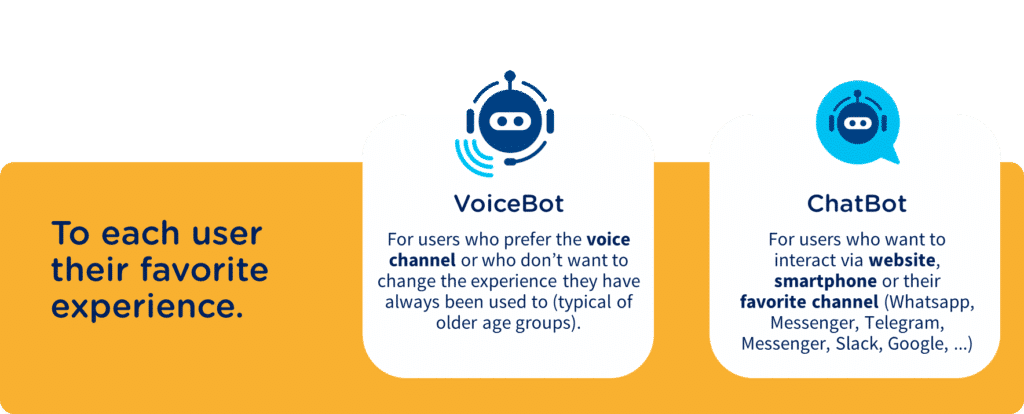 Fiamma Romano - 22 Settembre, 2023 - 3 ’ read
Fiamma Romano - 22 Settembre, 2023 - 3 ’ readHow Conversational AI brings Business Innovation for Customers and Workers
The rise of conversational AI tech is transforming customer experience. Chatbots and voice bots make customer support faster while lightening the load for human agents – not only giving businesses a competitive advantage, but also meeting the increasing need for round-the-clock assistance and tailored interactions.
Let’s explore the benefits of conversational AI for both customers and agents, how it brings business innovation, and effective implementation strategies.
The Benefits of Conversational AI for Customer & Worker Experience
Conversational AI helps businesses offer a range of benefits for customer experience. Chatbots and voice bots can quickly solve common customer issues, freeing human agents to focus on more complex ones. They’re available 24/7, providing support whenever needed, and available to the customer from multiple touch points: WhatsApp, Telegram, Messenger, and more.
The accessibility of these services on everyday platforms not only makes it easier for customers to seek support but also enhances their experience, allowing them to use familiar tools and reach out in busy times, such as when they’re on-the-go, without needing to carve out the time for a phone call.
Of course, the voice channel still remains pivotal to customer service, as 65% of people still prefer to talk their issues out. Conversational AI technologies can mix and match the voice and chat channels to cater to every user preference.

Moreover, Conversational AI provides personalized experiences that foster trust and loyalty. By analyzing customer data, chatbots can offer tailored recommendations and promotions, enhancing satisfaction and engagement. Similarly, automated workflows generate sales leads by suggesting products or services that align with customer interests.
Conversational AI also enhances workers’ experience by allowing them to focus on unique customer queries. This increases efficiency and opens the door for professional growth by diversifying the requests operators handle. Moreover, while customers have a plethora of tools they can use to reach a business, agents will often have a single touchpoint to handle requests coming from different platforms. This is the experience provided by Imagicle Conversational AI integrated with Attendant Console, for instance.
And while every organization has its own challenges, the Conversational AI business innovation can be of help to almost all of them, from banks to hospitals, to schools, to governmental institutions.
Think about it: who doesn’t need more productive workers, satisfied customers, and faster communications? A bank employee can stop saying the opening times of the bank 14 times a day, a doctor can find his agenda filled with appointments without picking up the phone once, and so on – all because of a single chatbot handling repetitive requests. It’s fairly easy to understand why Conversational AI technologies are becoming every market’s new favorite adoption in their UC stack.
How Conversational AI Technologies Work
Chatbots and voicebots use natural language processing (NLP) to understand and respond to customer queries. NLP allows these technologies to interpret customer intent and provide relevant information or actions, such as directing them to a specific product page or scheduling an appointment.
To implement conversational AI, businesses can use pre-built chatbot & voicebot platforms or develop their own custom solutions, although the latter is more costly and requires the constant involvement of the IT department. Getting an out-of-the-box platform, especially a no-code one, helps save money and it’s easier to set and maintain.
Best Practices for Implementing Conversational AI Technologies
To ensure successful implementation of conversational AI technologies, businesses should follow best practices such as:
- Clearly defining the use cases for the chatbot or voicebot. This helps in creating a more focused and targeted user experience. In addition, a well-defined use case allows for better alignment between the capabilities of the chatbot or voicebot and the expectations of the users.
- Providing clear guidance for users on how to interact with the technology. By providing step-by-step instructions and intuitive user interfaces, users can navigate and utilize the technology with ease.
- Regularly reviewing chatbot data. By analyzing the data, valuable insights can be gained, allowing for an upgrade of performances and identification of areas for improvement, ultimately optimizing user experience.
- Offering customers the option to speak to a human agent. Sometimes a human touch is needed. If the chatbot or voicebot is unable to solve their issue, businesses should ensure that customers can receive personalized assistance and have their concerns addressed effectively.
Conclusions
By investing in conversational AI technologies, businesses will be well-positioned to stay ahead of the curve and meet customer demands for an optimized experience.
This blog post only scratches the surface of what conversational AI can do for customer service and user experience. If you’re interested in learning more about how these technologies can benefit your business and if you’re looking for a conversational AI provider that follows the best practices and guides you into a flawless experience, look no further – check out the Imagicle Digital & Voice Virtual Agents.
Discover Imagicle Voice & Digital Virtual Agents.
See the application in action.
Potrebbe interessarti anche...
-
Products BlogReceptionist virtuale: cos’è e perché utilizzarloScopri cos'è un receptionist virtuale basato su AI, come funziona e i vantaggi che offre. Migliora l'efficienza e la soddisfazione dei tuoi clienti.
-
Scopri
Products BlogMeet Imagicle Virtual Receptionist, the digital twin of your human receptionists.Discover how you can bring your customer service to 10 without efforts. -
Products BlogNew Customer Service Analytics for Webex Calling Multi-Tenant.Explore Imagicle's new reports for Webex Calling, optimizing Customer Service with comprehensive call analytics.
 Scopri
Scopri







